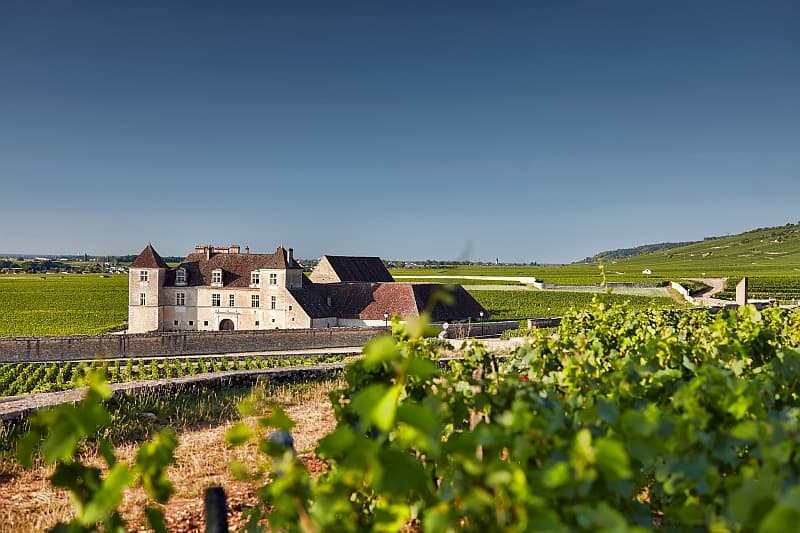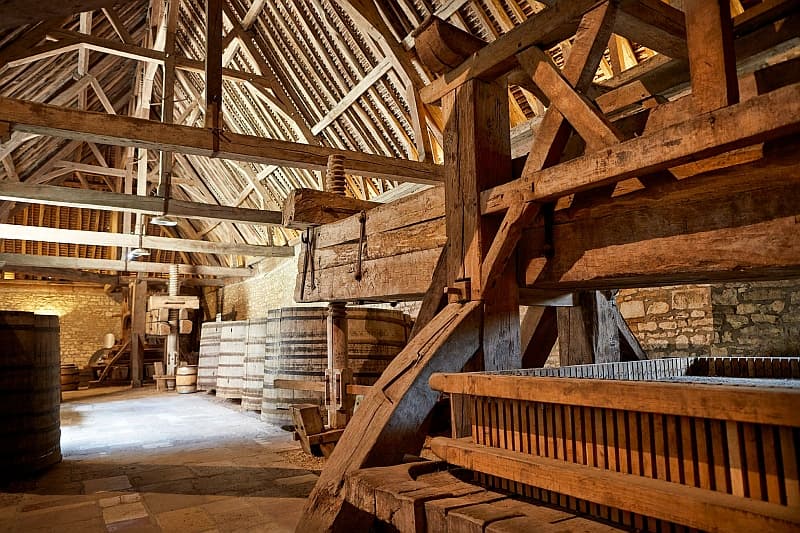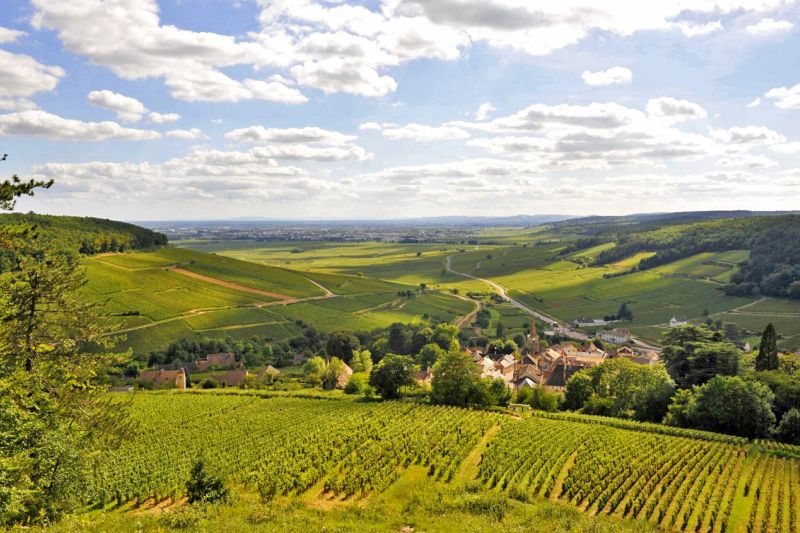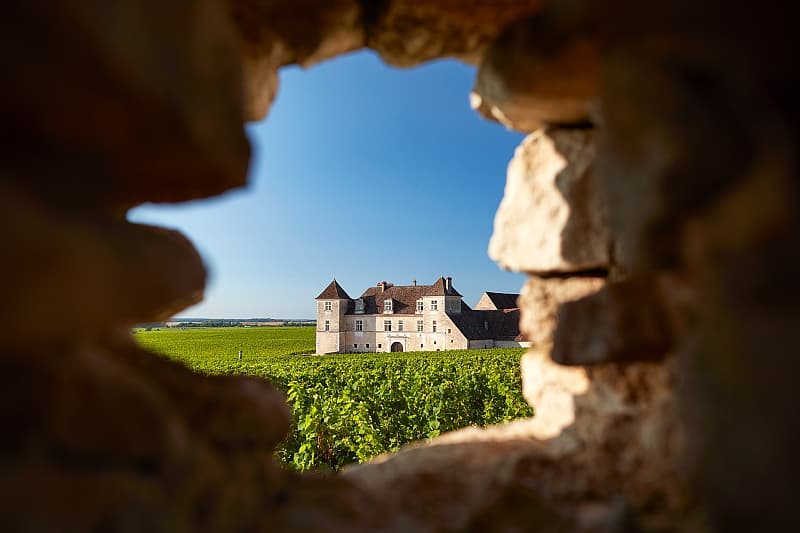The Clos de Vougeot is one of the most exclusive vineyards in the world. Situated at the heart of the Burgundy region of France, it covers an enormous fifty-one acres of land and is a designated UNESCO World Heritage Site. Originally established as a wine farm by Cistercian monks from the Abbey of Cîteaux, the site is internationally recognised as representative of Burgundian wine-making and the elite of the wine-loving world.
Clos de Vougeot: Home of the Chevaliers du Tastevin

The Winery and Château of Clos de Vougeot
At the centre of the Cote de Nuit region of Burgundy stands the large winery of Clos de Vougeot. In medieval times, the facilities housed in the wooden barn allowed wine production on an industrial scale. The medieval building contains four wooden grape presses and several enormous, historic storage vats. The cellars, with their high, vaulted ceilings, can accommodate up to 2000 casks of wine. Guests can visit the historic winery and even see the dormitory of the lay brothers, with its original woodwork beams, dating from the 1300s.
In 1551, a large chateau was built to replace the chapel and some smaller outbuildings, creating a more comfortable place to live. The château is privately owned and not open to the public, though it does host special events for the Chevaliers du Tastevin!

Confrérie des Chevaliers du Tastevin
Home to the Confrérie des Chevaliers du Tastevin, which translates as ‘Fraternity of the Brotherhood of the Knights of the Wine-Tasting Cup’. Founded in 1934, this exclusive society of Burgundian wine-lovers admits members from all over the world. Its total membership stands at over 12,000 at the present time of writing.
The Chevaliers du Tastevin meet up to seventeen times a year to celebrate their love of Burgundian wine. Around 500 members are invited to Château de Clos de Vougeot for a Cordon Bleu 6 course meal. Each dish is served, paired with one of the finest wines from the Burgundy region.
These special events are a celebration of Burgundy, the wines it produces, and its distinctive culture. A black-tie dress code is accompanied by light entertainment, in the form of historic costumes and performances. New members of the Chevaliers du Tastevin are initiated during a ceremony and older members proudly display medals they have collected from the society.

Burgundian Wine Production
Making wine is a laborious process that requires patience and passion. Wine production in Burgundy began over 2000 years ago when the Romans discovered that the conditions there were ideal for growing and harvesting grapes. Christianity accelerated production, with so much wine needed to fill the chalices used for Holy Communion in churches. For over 1000 years, wine was produced by monks, though they eventually passed the baton to the people of the towns.
The winemakers of Burgundy have been farming the region for generations, producing some of the best wine in the world. Their commitment to their trade means that they oversee the production personally, from tending to the growing vines to fermenting the wine and bottling it. Much of the work on the vineyards is still done by hand, with practices varying from family to family.

The valleys of Burgundy are fertile, but the vines grow better on the slopes. The microclimate and geology of the region means that no two wines from Burgundy are the same, even when they are made from the same grapes. The chalk and flint terrains produce some of the most expensive wines in the world. The region is split into thousands of separate territories, each of which is owned by different families, who practice unique winemaking processes.
Once planted, vines take seven years to fully mature, fruiting for up to one hundred years in total. The winemakers do not rely on watering or irrigation systems and are solely dependent on the weather to provide the vines with all that they need to grow. Without watering, Burgundian growers claim that the roots of the vines dig deeper into the soil to drink, this better defining the flavour of the grapes.
Harvesting the grapes begins in August or September, depending on the weather. Burgundian winemakers are strangely superstitious, choosing to harvest approximately one hundred days after the vines have bloomed, yet before the full moon. They are, however, practical, and avoid hail and rainstorms, which can damage the fruit.

The Clos de Vougeot Vineyard
The more than fifty hectares of Clos de Vougeot vineyards are still defined by the same historic walls that were built to surround the land 500 years ago. The area is divided between landowners, and only the pinot noir grape is grown there. Renowned for its excellence, the Clos de Vougeot vineyard is famous for producing prestigious Grand Cru Pinot Noirs.
The terroirs each have their own special characteristics, with each area of soil being slightly different to the one next to it. The Clos de Vougeot vineyards averages a height of 255 metres above sea level. The top end of the slopes has a terroir of coarse-grained, gravelly soil over a limestone base. The middle section has brown, clay soils, which lay over broken limestone. The bottom of the vineyard is of marl, rich clay and alluvium over rocks from the Jurassic era. These soils help to differentiate the flavours of the wines made from the vines in the Clos de Vougeot.
Though the wines made in the area are all different, they have common features. These include an intense red colour to the wine, floral bouquet of roses and violets and a hint of mignonette. The wines produced in Clos de Vougeot have flavour profiles of blackberries, raspberries, wild mint, liqorice and truffle and they leave a rich taste on the palate. A good age for a Clos de Vougeot Grand Cru is between ten and thirty years, though these wines can be kept much longer. Clos de Vougeot Grand Cru pairs best with rich meat dishes, such as beef, lamb, veal or game and accompanied by mushrooms.
Barge Cruises aboard Finesse and L’Impressioniste
Our barges, Finesse and L’Impressioniste, navigate the canals close to the Burgundy vineyards, through picture-perfect postcard villages and romantic countryside. The waterways are only five metres wide at the locks and our vessels glide through the canals at ease, stopping for you to take in the local area and immerse yourself in the culture, food and wine of the region.
Why not book a barge cruise in Burgundy today and visit the Clos de Vougeot to experience its remarkable history yourself? Find out more about our itineraries in Burgundy or contact us to enquire about booking.

 English
English
 Spanish
Spanish French
French German
German Norwegian
Norwegian Portuguese
Portuguese Swedish
Swedish Italian
Italian Russian
Russian Simplified Chinese
Simplified Chinese Japanese
Japanese
